The last five years of my retrospective are kind of hard to write because (a) they are so recent that anybody who has been following this blog has seen the games before; and (b) I also haven’t been playing much. One tournament in 2016, none in 2017, two in 2018, two in 2019, and one in 2020. Only six tournaments in five years!
Nevertheless, the two tournaments I played in 2019 were both memorable and fun, in different ways. In January I played in the Bay Area International, which was held for the first time in five years. It was a great chance to test myself against really tough opposition. I did okay but not great, with one win, three losses and four draws.
Ten months later I played in the Kolty Chess Club Championship. This was my first time playing at “the Kolty,” but I already knew a lot of the players there from going to Mike Splane’s chess parties. It was a seven-round tournament, one day a week. I like that kind of tournament; it gives the drama some time to build.
Going into the tournament, I wasn’t expecting to win it. I expected to be rusty, and also I had to take a half-point bye in round one because of a schedule conflict, so I would be starting out half a step behind the competition. I was the fourth seed, behind Mike Splane (#1), a five-time champion; Vlad Getselevich (#2), a somewhat unknown quantity; and Juande Perea (#3), a three-time champion. I expected that I would have to play at least one and perhaps two of those people.
But the tournament worked out in a completely unexpected way. Eric Steger, a class-A player who started out as the #13 seed, decided to play the tournament of his life. In three consecutive rounds he beat the three top seeds, and both Getselevich and Perea withdrew after their losses. Mike Splane kept playing after his loss to Steger but was not in his top form, perhaps because of the medical issues that had already started and that eventually took his life this year.
So with the highest-rated players out of contention, the big question was whether anybody could catch up to Steger. After five rounds he was a perfect 5-0. I gave up a draw in round four in addition to my half-point bye in round one, so I had a record of 4-1. In round six we were paired against each other, and it was basically win or go home for me. With a win or a draw Eric would eliminate me from contention for first place.
I’m showing you the game, so you can probably guess who won. It’s a game that I’m very proud of, because I won a must-win game against a player who had just beaten three masters in a row, and also because it was not easy. It’s a great example of how to stir up trouble in a position that has not gone very well for you.
The game is also interesting (and I mentioned this in my blog last time I wrote about it) because I was able to successfully use a “scouting report” that Mike Splane gave me before the game. He told me that he had never seen Steger play a sacrifice. That was really interesting because if he never plays sacrifices himself, he is unlikely to anticipate sacrifices from his opponent. On move 20 an opportunity presented itself to play a complicated, speculative pawn sacrifice. I really couldn’t determine whether it was sound or not, but I played it anyway, in part because I thought he would be more uncomfortable in the resulting position than I was. Sure enough, he accepted the sac but then he almost immediately went wrong. The win after that was pretty easy.
Even after looking at it on the computer, I still don’t know if my sacrifice was “objectively correct.” But from the practical point of view — and especially in view of my opponent’s psychology — it was exactly the right thing to do.
Dana Mackenzie — Eric Steger
1. e4 d6 2. f4 Nf6 3. d3 g6 4. Be2 c5
Transposing from a Pirc into a Grand Prix Sicilian. I play this system a lot, and it’s convenient that I can learn one system for two different openings.
5. c3 Nc6 6. Na3 Rb8 7. Bd2 …
I have to say something about this move, too. For a long time after I started playing the Grand Prix Sicilian, I would develop my bishop on e3, thinking that I was protecting the weak dark squares in my position. Eventually my chess friend and fellow master, Gjon Feinstein, asked me why I kept putting my bishop there. That’s the first time it occurred to me that putting a piece on a weak square (e3, in this case) does not make it a strong square! It only makes that piece a target.
By not putting the bishop on e3, I also leave that square free for my knight later on.
7. … b5 8. Nc2 Bg7 9. Ne3 e6 10. Bf3?! …
This is taking eccentricity to an extreme. More natural is 10. Nf3. By playing all those moves with my knight (b1-a3-c2-e3) and now with my bishop (f1-e2-f3) I’m getting behind in development.
10. … Qb6 11. Ne2 a5 12. O-O O-O 13. Qe1 Ba6!
I like this move, getting ready to probe the weakness created by my 10th move.
14. Rd1 …
This position is so comical that it needs a diagram.
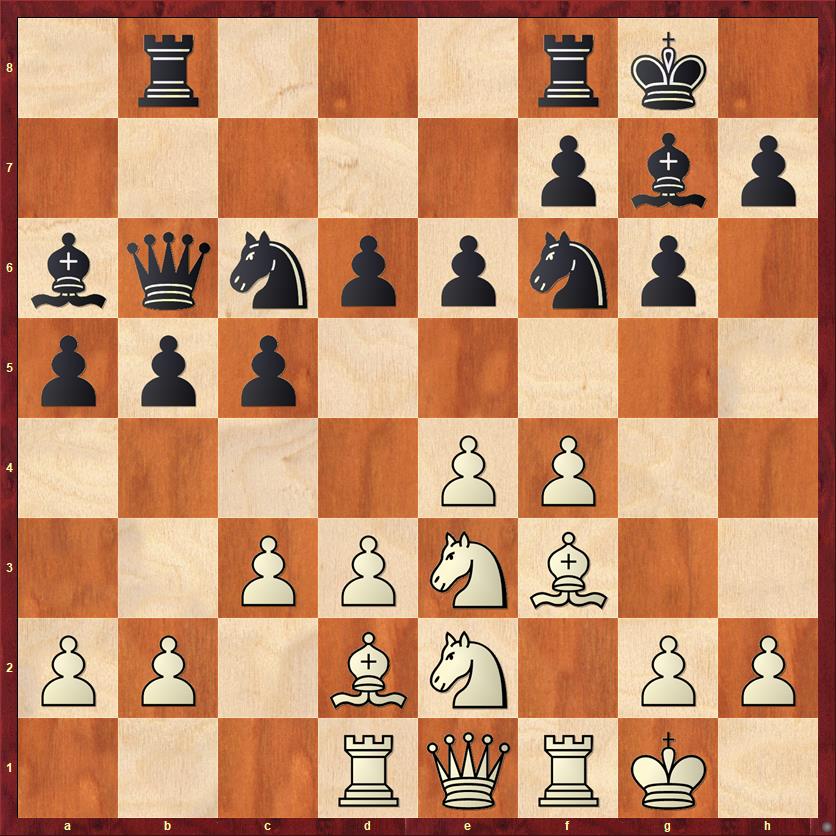
FEN: 1r3rk1/5pbp/bqnppnp1/ppp5/4PP2/2PPNB2/PP1BN1PP/3RQRK1 b – – 0 14
All of my baroque maneuvers have gotten me into a position where all of my pieces are piled up like football players. As Mike Splane would say, my pieces are all looking at the rear ends of my other pieces. Compare this to Black’s development, where the pieces are well spaced and the bishops are on nice diagonals where they attack (or will attack) White pawns. There’s no question who has played the opening better, and it’s not me.
The one saving grace is that there is no direct contact yet between the two armies, so there is still time for White to start untangling his position. Also Black does have one problem: the “Swiss cheese pawn formation” on the kingside, h7-g6-f7-e6, which leaves the dark squares weak. I had won a similar game in round two where Black gave himself that formation and I brought my queen to h4, and I was eager to try again.
14. … Rfd8 15. Qh4 d5 16. e5 Ne8 17. Ng4 …
This hyperactive knight continues its journey across the board. For the first time, though, I have a concrete plan. Mike Splane would ask, “How am I going to win this game?” For me, the answer was, “Get my knight to f6.”
17. … Rd7!
My opponent is playing very well. He isn’t the least bit afraid of 18. Nf6+ because he would win a pawn after 18. … Nxf6 19. ef Qd8.
18. Be3 …
Possibly 18. Be1 was better. The reason 18. Nf6+ didn’t work was that my queen was undefended. 18. Be1 would take care of that problem, so that Nf6+ would become a threat.
18. … b4
Possibly 18. … h5 was better, for the reason just mentioned. If 19. Nf6+ Nxf6 20. ef Qd8 21. Bxc5 Bxf6 Black’s position is clearly better, as he controls all the attacking lines.
19. d4?! …
This is the point where I started writing about the game in my previous post, after skipping the first 18 moves. I took 25 minutes on this move, looking at more patient options like 19. Bf2 (probably best) or 19. Rd2 or 19. b3, but these moves had little appeal to me.
I finally decided that I wanted to play a move with more fighting spirit. Although objectively I think Black could have gotten the advantage, I can’t call this move an out-and-out blunder. I had the sense after 18. … b4 that my opponent was starting to take over the narrative of the position and forcing me to react to him. This move, along with my 20th and 21st moves, was a very deliberate attempt to “take back the microphone.”
19. … c4?
This move, on the other hand, is in my opinion very misguided. First, it releases the pressure on White’s center and thus allows me to pursue my kingside attacking ambitions with fewer worries. And second, even if you think that … c4 is a good move for Black, you should at least play 19. … Bxe2 first, trading off your bishop so that it doesn’t get locked behind the pawn chain. Third, he played this move much too quickly. (Perhaps, because of my 25-minute think on the previous move, he had already decided what to do?) From the strategic point of view, this was a very important moment. He should at least have considered the pawn trade on c3 and the pawn trade on d4, opening lines for his pieces.
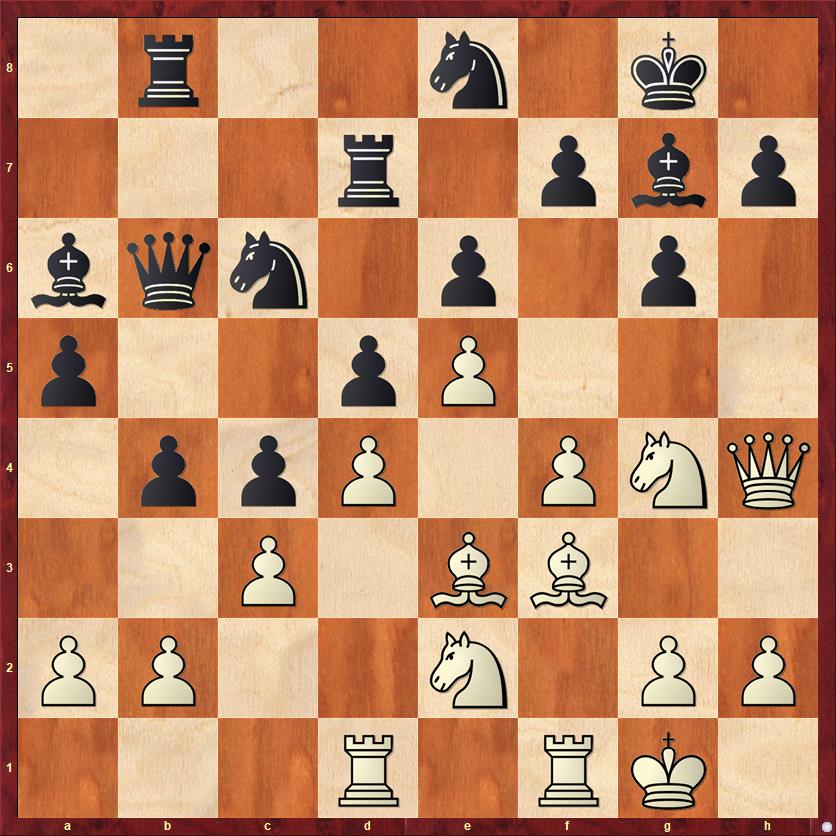
FEN: 1r2n1k1/3r1pbp/bqn1p1p1/p2pP3/1ppP1PNQ/2P1BB2/PP2N1PP/3R1RK1 w – – 0 20
The most important move of the game. I was sure that Black had made a mistake by not taking my knight, so I asked, what is a good way to punish him for that mistake?
20. f5! …
A bombshell! I’m sure that my opponent wasn’t expecting this. It’s a beautiful example of a sweeper-sealer. It sweeps open the c1-h6 diagonal so that my bishop can participate in the attack. It also sweeps open the f4 square, which my knight can use effectively. Mike Splane would say, “You lost a pawn but you gained two pieces.” Long-term, it can also sweep open the f-file for my rook. Furthermore, it seals off the f5 square, which would have been a great defensive and offensive square for Black’s knight, but now will not be available. And it also weakens the defense of the d5 pawn, which Black will now have to treat with velvet gloves. All this for the price of a mere pawn! From the strategic point of view, it’s a wonderful move.
Nevertheless, it was hard to be sure whether the move worked tactically, so it took a bit of courage for me to play it. I could just end up a pawn down.
20. … ef 21. Nf6+!? …
The computer — both Rybka in 2019, and Fritz today — thinks that White should play 21. Nh6+ Kh8 22. Qf2 (to prevent any captures on e5). Then g2-g4 is in the cards, and the knight on h6 helps put pressure on the f5 pawn.
Nevertheless, I already had decided on my answer to the Mike Splane Question: I was going to win by putting my knight on f6.
21. … Nxf6 22. ef Qd8 23. Bg5 h6
Of course, Black can’t allow the “bone-in-the-throat” pawn on f6 to remain. Steger must have been optimistic at this point; trading the h6 pawn for the f6 pawn looks like a pretty good deal for him.
24. Bxh6 …
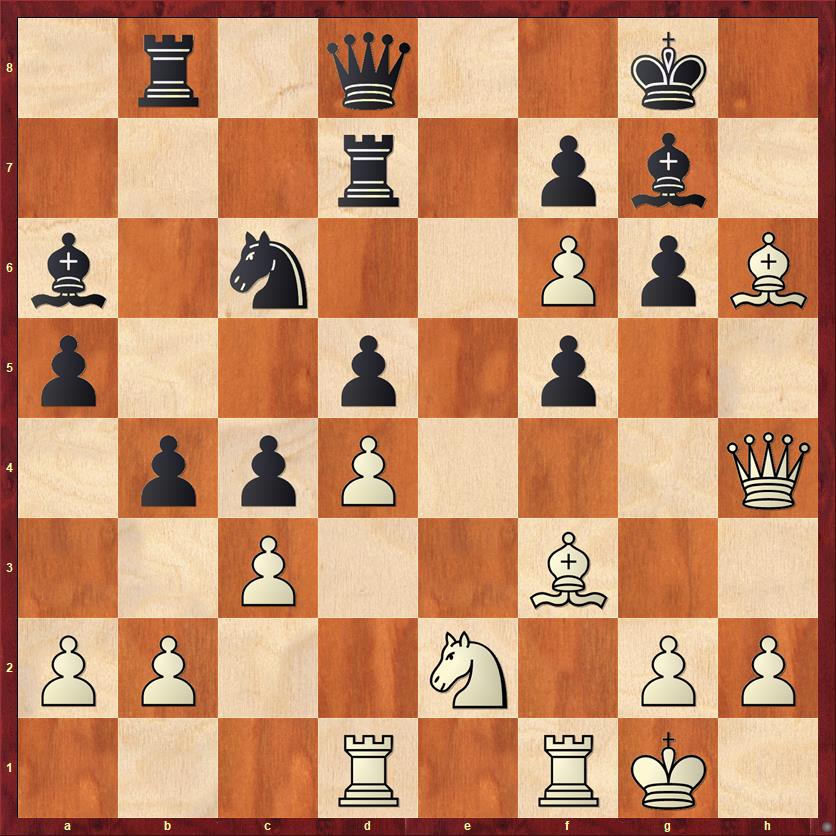
FEN: 1r1q2k1/3r1pb1/b1n2PpB/p2p1p2/1ppP3Q/2P2B2/PP2N1PP/3R1RK1 b – – 0 24
The final turning point of the game. Black played the very bad move:
24. … Qxf6??
You’d have to ask Eric why he played this move. Maybe he thought I would have to trade queens, after which he would have a very comfortable pawn-up ending. Or maybe he overlooked my next move, or missed something after that move.
From the pure chess point of view, it’s too bad that he didn’t play the correct move, 24. … Bxf6, because I would be very curious to see what would have happened next. My plan was to play 25. Qh3 (diagram).
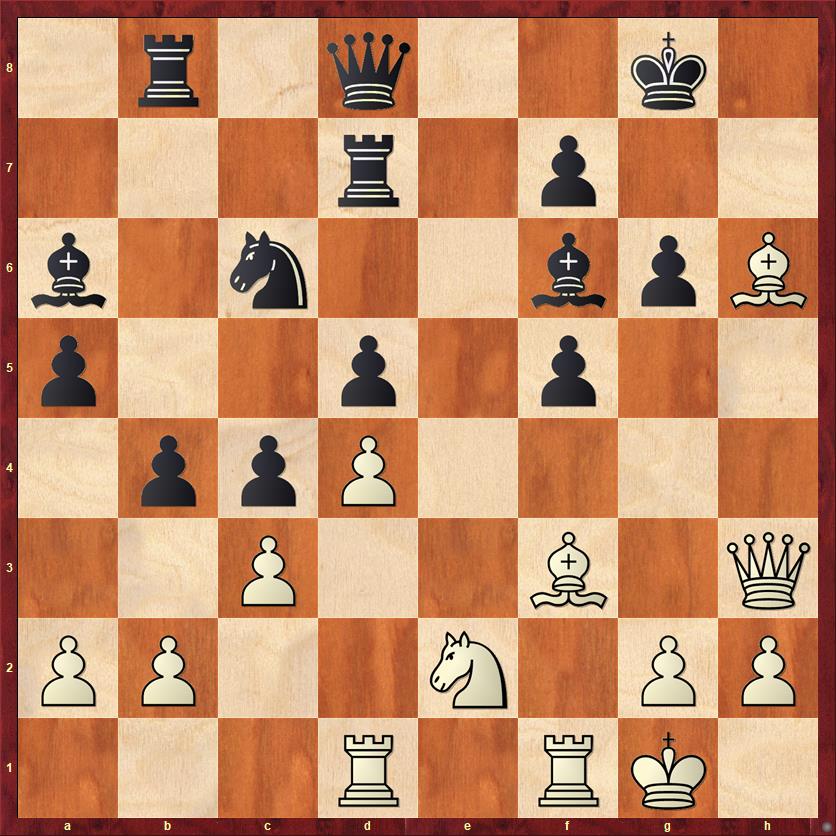
FEN: 1r1q2k1/3r1p2/b1n2bpB/p2p1p2/1ppP4/2P2B1Q/PP2N1PP/3R1RK1 b – – 0 25
My claim is that White has full practical compensation for the pawn. This may seem unbelievable, because the computer evaluation of the position starts out at around +0.8 to +1.0 pawns for Black, in other words the computer believes that White has hardly any compensation. But when you go deeper into those computer lines, the alleged advantage for Black tends to melt away.
I’ll skip the computer analysis, though, and try to explain this position in human terms. Why is the position so hard for Black? First, he has to choose between many possible plans. Should he ignore my attack and storm the queenside with … Rb2, possibly taking on a2 and doubling his rooks on the seventh rank? Or should he place his bets on all-out defense, putting his bishop on c8 and knight on e7? Or maybe should he try to blockade the kingside with … g5 and … f4?
Second, no matter what plan Black chooses, it is hard for him to keep all of his weak points covered. The paramount target for White is the pawn on f5, which White will attack right away with g2-g4. Another target is d5. Also, Black has several loose pieces on a6, c6, and f6. And of course there is the huge problem of the Black king, which may come under fire on either the g-file (after White trades off his g-pawn) or the h-file. That king just has no safe place to go. And finally, off in the middle distance, White has dangerous sacrificial threats like Ne2-f4xg6 or Ne2-g3xf5, which could pulverize Black’s kingside.
While Black has a lot of things to worry about, White by comparison has very few things to think about. He will play g2-g4, and try to pile pieces on the f-pawn. At some point White will have to decide whether to play his knight to g3 or to f4; that is the only real subtlety in the position.
Just for giggles, and for people who like “What might have been?” questions, here is a sample computer line where the computer initially likes Black, and then shifts strongly towards White: 25. … bc 26. bc Rb2 27. g4 Ne7. So far this seems quite reasonable for Black; the knight on e7 defends a whole lot of weak points (d5, f5, g6). The problem, though, is that Black’s pieces are poorly coordinated, with the knight in the way of the queen and the rook in the way of the bishop (which wants to go to c8). Now the computer suggests 28. Ng3 f4 (trying to keep lines closed) 29. Bxf4 Rc2 (diagram).
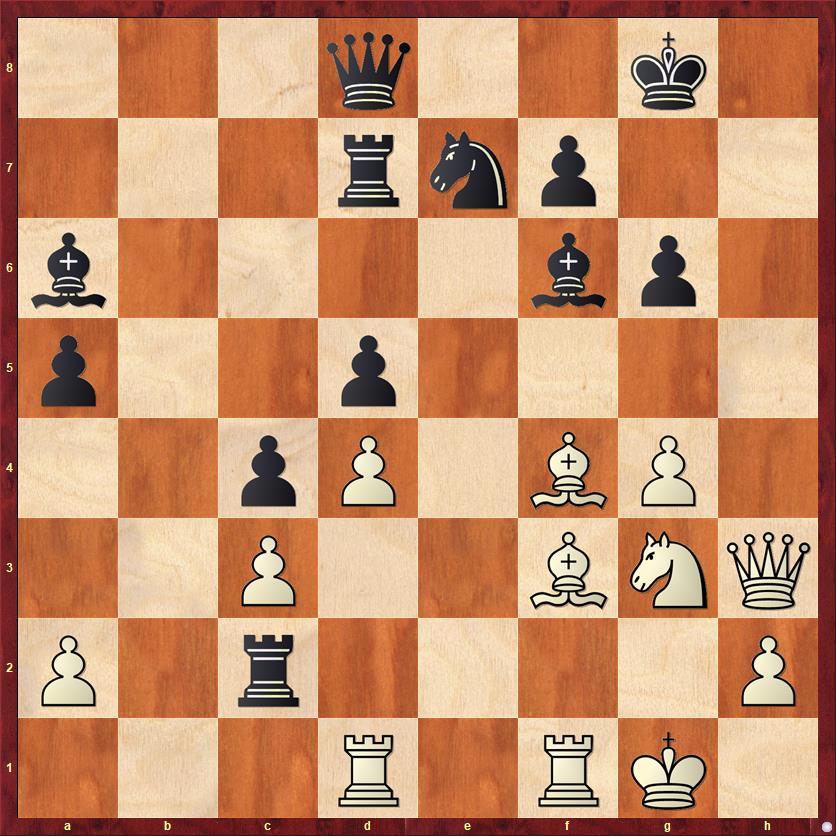
FEN: 3q2k1/3rnp2/b4bp1/p2p4/2pP1BP1/2P2BNQ/P1r4P/3R1RK1 w – – 0 30
Initially, when Fritz got to this position, it thought White had a slight advantage with 30. g5. But then, after about a minute of thought, it comes up with the unbelievable move 30. Nf5!! Holy cow! First, you have to see that if 30. … gf 31. gf White will have an irresistible attack on the g- file and h-file, and if Black’s king tries to run away with 31. … Kf8 then one of those loose bishops drops off after 32. Qh6+ Bg7 33. Qxa6. You saw that, right? Alternatively, if Black goes about his business with 30. … Rxc3, you have to see that White will blast the kingside apart with 31. Nh6+ Kf8 32. Nxf7!
Only in my dreams could I ever play this way, but it’s really inspiring to see what possibilities there were in the position. No wonder I couldn’t figure out whether I had compensation for the pawn.
Anyway, let’s now go back to reality. Back to the third diagram above. As noted earlier, Black blundered with 24. … Qxf6??, and I played
25. Bg5 Qe6
Black is kind of unlucky that the perfectly reasonable move 25. … Qd6 loses the exchange to 26. Bf4. Probably he should play that anyway, and try to draw the endgame after 26. … Qf6 27. Qxf6 Bxf6 28. Bxb8 Nxb8. The move he chose leads to a quick debacle.
26. Nf4 Qe3+ 27. Kh1 Re8?
Here, as I mentioned in my earlier post, Black has an amazing possibility of sacrificing the queen for a bishop and two extremely dangerous passed pawns: 27. … bc 28. Nxd5 Qxg5! 29. Qxg5 cb. This is the sort of thing that Black should try even if he can’t work it out completely, because every other move loses very quickly. However, remember that Mike Splane’s “scouting report” said that Steger never plays sacrifices. So it’s very unlikely that he will come up with a queen sacrifice in this situation, and indeed he didn’t.
28. Nxd5 Qe6 29. Nf6+ Black resigns
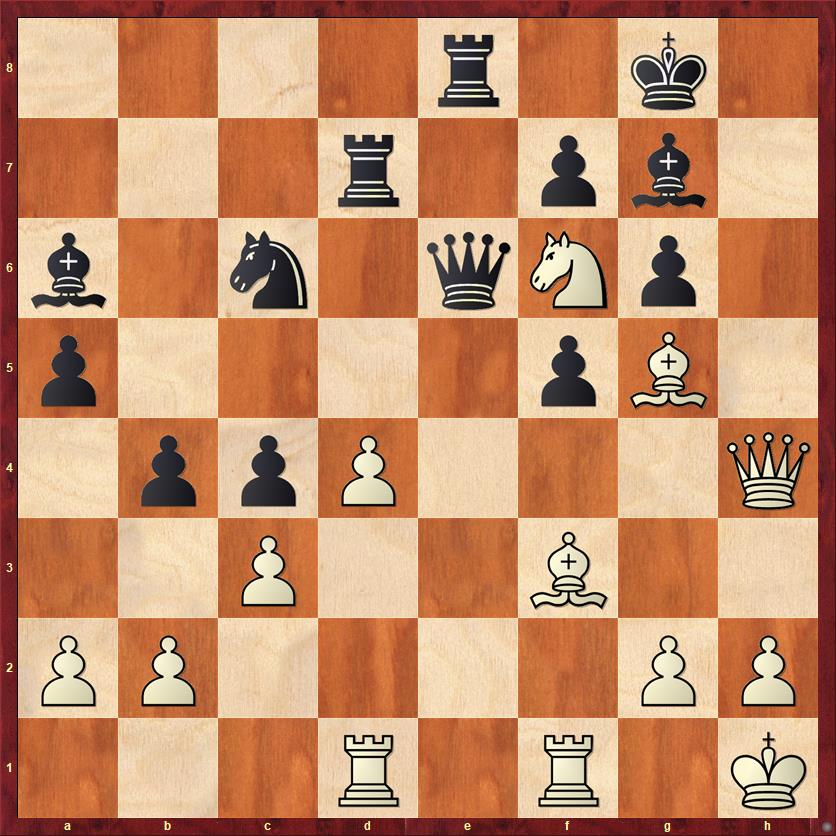
FEN: 4r1k1/3r1pb1/b1n1qNp1/p4pB1/1ppP3Q/2P2B2/PP4PP/3R1R1K b – – 0 29
If 29. … Bxf6 30. Bxf6 White’s strategy of dominating the dark squares is complete, and there is no stopping Qh8 mate. If 29. … Kf8 White doesn’t settle for winning the exchange with 30. Nxd7+? because there is a much better move: 30. Rde1!, and Black has to give up his queen to avoid checkmate.
I like this final position because it shows you the value of the Mike Splane Question (“How will I win this game?”). Very early on, as early as move 17, I had the idea that I was going to win by getting a knight to f6. In fact, both of my knights eventually went to that square! Of course there was nothing forced about it. The game could have gone differently and who knows, maybe I would have won with Nf5 as in that crazy computer variation that I showed you. But the Mike Splane Question gives you a North Star to sail your boat towards, and it’s really amazing how often it takes you all the way to your destination.
Oh, by the way, I should mention that I also won in the last round against Paulo Santanna, the #5 seed. Eric Steger kept pace by winning his last game, so we both ended up with 6-1 scores. However, I won the title of club champion on tiebreak. I feel a little bit bad about spoiling what was probably the best tournament of Eric’s life, but I can’t feel too bad! For me it was the first victory in a multi-day, open tournament in many years. I have only won four such tournaments: the 1988 Georgia Congress (Atlanta), the 1989 Roosevelt Open (Dayton, OH), the 1993 Roosevelt Open (Dayton), and the 2019 Kolty Club Championship (San Jose). Twenty-six years is a pretty long wait!
Lessons:
- Try to control the “narrative” of the game. If your opponent is starting to dictate the action, look for enterprising ways to take back the microphone, even if it costs a little material. Sometimes it’s not the smarter player who wins, it’s the more determined player.
- Learn about sweeper-sealers. These “impossible” pawn sacs open lines for your own pieces while sealing off good squares from your opponent’s pieces.
- To play a sacrifice, you don’t always need to analyze it all the way to a win. In fact, it may be a waste of time to attempt to. You should analyze enough to make sure your opponent doesn’t have an easy defense. It’s a big plus if your sacrifice forces him to make difficult decisions, and if you have so many different threats that it’s hard for him to stop them all.
- Ask the Mike Splane Question: How will I win this game? But remember that it’s only a guide; be prepared to change your plan if circumstances require it.



{ 4 comments… read them below or add one }
Hi Dana,
I wanted to thank you for this blog in general, and for your Bryntse Gambit posts in particular. Last weekend I played in the WA Women’s Championship, and in round 2 managed in a moment of complete inanity to drop my queen to an underrated girl. But I had two bishops for it, a half-open f-file leading to her isolated, doubled f-pawns, and a knight with potential to invade. I thought a good deal about your handling of the queen sack–in particular “Be patient”, “Don’t cash in too soon”, and “Don’t let her invade.” I managed to slowly shred her kingside with all of my pieces, taking a bit of material here and there, and won the game. This set me up for a last round confrontation much like the one you describe in this blog–my opponent was 4-0, I was 3-1 and needed to win–and I managed to do so, tying for first.
Thanks so much for the lessons!
Hi Mary,
What a great comment! First, congratulations on your victory in the Washington Women’s Championship! I’m thrilled to think that some of the things I wrote helped you, and I would really love to see the moves of your queen-versus-two-bishops game. You can post them in a comment or send them to me in an e-mail, whichever you prefer.
Sure! Annotations aren’t done yet, but here are the moves:
[Event “WA Women’s Championship”]
[Site “Redmond, WA, USA”]
[Date “2021.09.11”]
[Round “2”]
[White “Iris Zhang”]
[Black “Mary Kuhner “]
[Result “0-1”]
[BlackElo “1878”]
[ECO “C05”]
[WhiteElo “1387”]
1. e4 e6 2. d4 d5 3. Nd2 Nf6 4. e5 Nfd7 5. Ne2 c5 6. c3 Nc6 7. Nf3 cxd4 8.
cxd4 f6 9. exf6 Nxf6 10. Nf4 { This does not look right at all; the knight is
going to be unstable on the half open f-file. Usually it goes to c3. Why it is
okay for White to play the Ng1 to c3 and the Nb1 to f3, which seems like a pure
loss of tempo, is one of the mysteries of the Tarrasch.} 10… Bd6 ( 10…
Bb4+ 11. Bd2 Bxd2+ { is the engine’s recommendation, which it rates at nearly
-2. White has too many competing demands: protect the loose piece, hold the
d-pawn, get the king to safety.} )11. Bb5 $2 { White players unfamiliar with
the French very often want to put the bishop on this square: I have won
innumerable blitz games as a result, as it’s almost always wrong. Here there’s
an immediate tactical refutation.} 11… Qa5+ 12. Bd2 Qxb5 13. b3 O-O 14. Rc1
Ne4 15. Ne2 Nb4 16. O-O { White can at least be relieved to get her king out of
the center.} 16… Nxa2 { Greedy. Mainly I wanted to secure b4 for the knight
permanently, and also move her rook to a ( hopefully ) worse square: the
pawn was a secondary concern.} 17. Ra1 Nb4 { Two tempi for the pawn; probably
fine in a position where White has few threats.} 18. Nc3 { I can tell you
exactly what I was thinking here. I can either trade the knight, or play …Qe8
and transfer my queen to the kingside for a potential attack. I had trouble
deciding which, though. Both moves had some awkward aspects. Then suddenly I
thought, I don’t actually want to trade my knight for her knight, strategically
I’d rather have the bishop. –Kotov talks about this in _Play Like a
Grandmaster_: you debate move A and move B, can’t decide, and suddenly play
move C without analysis. As soon as I did it, of course, I saw what I’d done
and said “Oh god” involuntarily. Apparently I would not make it as a poker
player, because if there was any chance Iris would miss that I’d just hung my
queen, this blew it….} 18… Nxd2 19. Nxb5 Nxf3+ ( { Not } 19… Nxf1 20.
Nxd6 { and I can’t get the knight out again so lose even more material} )20.
gxf3 Bb8 { Time to take stock. I have only two bishops and a pawn for the
queen. I do have the bishop pair, though they are not too active yet. The pawns
on f2 and f3 are doubled on a half-open file and are very weak; in general her
pawn structure is shattered. And her king may not be safe on the kingside. It’s
not as bad as it could be. I also have a pawn break in the center when the time
is right; maybe I can get the light-squared bishop mobilized that way.} 21.
Kh1 { Iris develops a plan of her own, namely mating me down the half-open g
file. It’s not a bad idea in principle, but her weaknesses are going to catch
up with her.} 21… Bd7 22. Nc3 22… Bd6 23. Rg1
Rf6 24. Rg2 Raf8 25. Rxa7 Bc6 26. Qg1 g6 27. Ra1 e5 28. Ne2 28… Nd3 29. Rd1 e4 30. f4 Bxf4 31. h4 Bd7 32. Rxd3 exd3 33. Nxf4
Rxf4 34. h5 Bf5 35. f3 Rxf3 36. Rg3
Be4 37. Kh2 Rf1 38. hxg6 Rxg1 39. gxh7+ Kh8 40. Rxg1 Bxh7 41. Rg2 Be4 42. Rd2
Rc8 43. Kg1 Rc2 44. Rd1 d2 45. Kf2 Kg7 46. Ke3 Kf6 47. Rxd2 Rxd2 48. Kxd2 Ke6
49. Kc3 Kd6 50. Kb4 Kc6 51. Ka5 Bd3 52. b4 b6+ 53. Ka4 Bc4 54. Ka3 Kb5 55. Kb2
Kxb4 56. Kc2 Ka3 57. Kb1 b5 58. Ka1 b4 59. Kb1 b3 60. Ka1 b2+ 61. Kb1 Bd3# 0-1
Nice game! I like the way that you kept your wits about you after blundering the queen. It would have been so easy to go into a funk, because you were so far ahead before that and now you’ve got to start over from scratch (or even from behind). Once you got your pieces out and organized, the position was all fun for you and nothing but headaches for her.